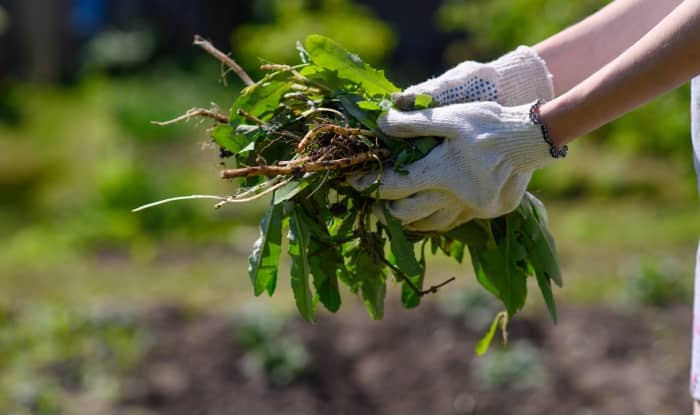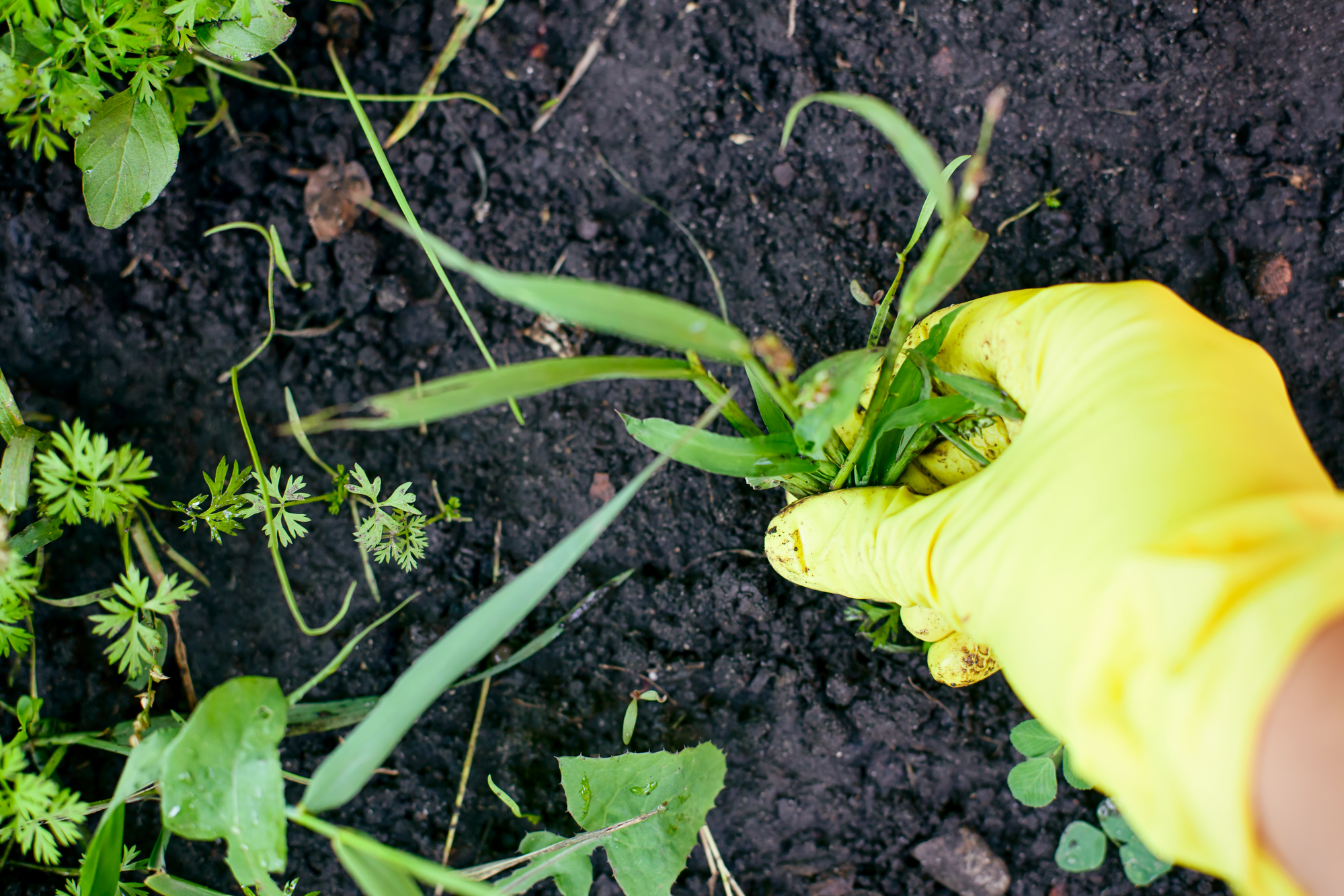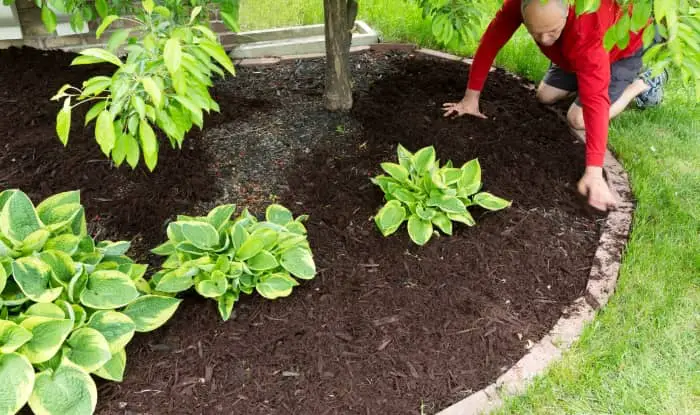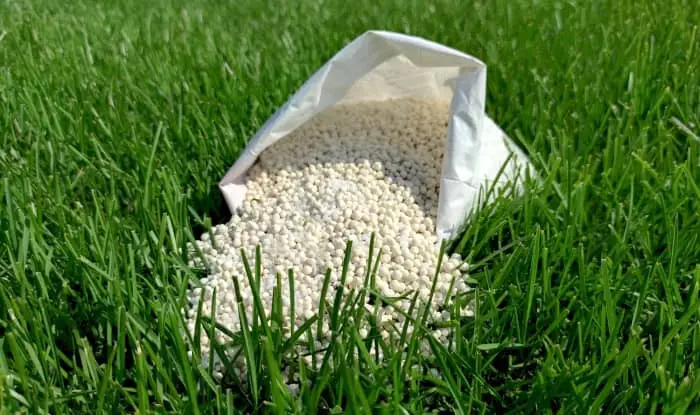Regular weeding is an essential and sometimes frustrating task that every gardener has to make time for.
Weeds deprive your plants of water, sun, and nutrients, inhibiting healthy growth. And they give an untidy and uncared-for appearance to your garden.
Pulling weeds by hand is one of the simplest ways of fixing the problem. When done correctly, hand-pulling can get rid of weeds permanently. But get it wrong, and the weeds can grow back and even spread.
Weeding can also be hard work. So in my list of tips, I’ll give you advice on how to get the job done right the first time and how to reduce the time and effort it takes.
Simple Tips For Removing Weeds
Pulling weeds doesn’t have to be hard work. Here are my top hand weeding tips:
Don’t Wait To Weed
Don’t ignore weeds that are growing in your garden. It’s tempting to leave them for later. But it’s easiest to pull them when they are young. Mature weeds often develop a deep and more extensive root system, making them difficult to remove completely. This is a problem because they sometimes regrow from pieces of roots left in the ground.
Small, young weeds usually have a more shallow root system, making them easier to remove without leaving any pieces behind.
If you weed regularly, the job takes less time and effort.
Grab The base To Pull Out The roots
It’s helpful to pull a weed out of the ground in the correct way. Don’t grab hold of the weed halfway up and give it a hard yank. The weed is likely to break in two, leaving the roots in the ground.
Instead, hold the weed as close to the ground as you can. If you grab hold of the weed at the base and pull it slowly, it is less likely to break.
Don’t Strain Your Back
Weeding is easier if you kneel or sit on the ground. Bending over while standing places strain on your back. If you have many weeds to remove or the ground is wet, it’s worth using a small stool so you can sit down and make yourself comfortable.
Use Garden Gloves
Weeding can be rough on your hands and fingers, particularly if the weed has prickly spines. You’ll find it a lot more comfortable if you use a good pair of gardening gloves.
It’s easier to use gloves with a wrist closure keeping them in place while you work. And it’s helpful if the gloves are puncture-resistant. Look for extra padding in the fingertips and palms of the glove.
Weed When The Soil Is Wet
It’s a lot easier to pull weeds out of the ground when the soil is wet. A good time is the day after it rains. If you don’t want to wait for the rain, you can water the ground around the weed to make the soil moist.
You’ll also find it easier to pull the weeds out with their roots if the soil is soft, loamy, and well-draining. This type of soil is light and less compacted than heavy clay soils that keep the weeds fixed in the ground.
To lighten your soil and improve drainage, add organic matter such as dried leaves and compost. Work the organic matter into the top layers of soil using a shovel or trowel.
As well as making it easier to remove weeds, adding organic matter also creates healthier soil for your plants to grow in.
Loosen The Topsoil
Loosening the top layer of soil reduces resistance, allowing you to remove the weeds with one smooth pull. Loosen the soil where the stem meets the ground until you can see the roots connecting to the plant. Grab as much of the taproot or main root as you can when lifting the weed out.
Up And Out
Using the correct technique can prevent the roots from breaking off. Pull up and out, rather than at an angle, to keep the plant in one piece.
Use A Tool To Help You
Removing weeds with shallow root systems in soft soil is fairly easy. But if they have deep roots, pulling is a lot more difficult. To make it easier, you can use a weeding tool.
If roots are left behind, you can use the tool to dig deeper and remove the pieces. And if it’s too difficult to pull the weed, you can dig around and under with a shovel. This makes it easier to lift the weed and its roots out of the ground.
If you want to stand up while you work, then a long-handled corkscrew weeder is a good choice for removing weeds with taproots, such as dandelions. Screw the weeder into the ground around the weed. Then lift the weed out of your lawn along with the taproot.
To remove weeds growing between patio and paver stones, you need a tool with a narrow edge. Try a Cape Cod weeder or v-notch weeder that can dig into the cracks and help you lift out the roots.
And if you’d prefer not to use your hands to pull weeds, a claw rake can help if the roots are shallow.
To remove weeds growing between desirable plants, you can use an angled hand hoe that can get into tight spaces.
If it’s too difficult to pull them out, you can kill the weeds by cutting them down or using a flame torch. But plants with extensive root systems will continue to grow back. So you might have to repeat the process until the root system exhausts itself.
What Type Of Weed Is It?
Before you start pulling weeds by hand, it helps to know what types of weeds you’re dealing with. Are they annual weeds with a shallow fibrous root system? Or are they perennial weeds with extensive root systems and rhizomes and tubers?
Depending on the types of weeds, you’ll know whether they can grow from leftover roots and if it’s possible to remove them by hand without the use of tools and herbicides.
It’s also important to know if they are safe to touch. Some weeds can cause an allergic reaction, such as poison ivy. And other weeds have phototoxic sap, such as giant hogweed.
What To Do After?
After removing the weeds from your yard, take action to prevent them from returning. While preventative action won’t stop all the weeds, it will significantly reduce the amount of work you have to do in the future.
Proper Disposal
After pulling the weeds out of the ground, it’s important to dispose of them properly. Don’t leave them lying on the ground. Many weeds can reroot from stem nodes and pieces of roots and ribosomes. And seeds can also get into the soil. Instead, carefully dispose of the weeds.
Some weeds are highly invasive. So don’t dispose of them on public lands where the weeds might spread, impacting conservation areas and public parks. And don’t put weeds that can reroot into your compost. Instead, place them in a waste disposal bag and place them in the garbage.
Use A layer Of Mulch
Apply a layer of mulch over the soil. This helps to prevent seedlings from developing after germination by denying them sunlight. Mulch also makes it harder for seeds to reach the soil.
Using mulch is good for your plants. Mulch helps keep moisture in the soil, essential for healthy plant growth. And if you use natural mulch, such as wood chips, straw, dead leaves, or cardboard, it will release nutrients as it decomposes, helping your plants grow.
It’s a good idea to pull weeds from the area before you mulch.
Pack Your Plants
Growing your plants close together crowds out weed seedlings, putting them in the shade and inhibiting their growth. But make sure your plants still have enough space to grow to their full size.
Use Pre-emergent Herbicide
One of the best ways to prevent weeds from returning to your garden is to use a pre-emergent herbicide.
When you apply it to the soil, it creates a chemical barrier that prevents weed development. After the weed seeds germinate, they start to produce roots and shoots. When the roots and shoots contact the pre-emergent chemical in the soil, they die.
For pre-emergent herbicide to work, you need to apply it before the seeds germinate. Once the weed is growing, it’s too late. The best times of year for applying a pre-emergent herbicide in your yard are early spring, and again somewhere between late summer and early fall.
In the spring, wait for the soil temperature to warm to 55°F for several days. You can use a soil thermometer to keep track of the temperature so you can apply the pre-emergent at the correct time. In the fall, wait for the soil temperature to drop to 70°F. To control weed species such as crabgrass and Poa annua it’s often necessary to apply a second treatment of pre-emergent a couple of months after the first.
It’s important to realize that pre-emergent herbicide doesn’t just prevent weeds, it also stops desirable plants from developing from seed. But it won’t stop plants growing that have established root systems.
Once you’ve applied the pre-emergent, leave the ground undisturbed. Don’t till or aerate the soil because it will disrupt the chemical barrier.
Lay Down Landscape Fabric
Landscape fabric is a popular method for preventing weed growth in perennial flower beds. Landscape fabric provides a barrier over the top of the soil that stops light from reaching the ground. This makes it harder for weed seedlings to develop into mature plants.
You can get various types of landscape fabric. But most are made of synthetic materials, such as polypropylene, and come in a sheet that you can roll out and cut to size. The fabric contains small perforations that enable water to reach the soil. After laying down the landscape fabric, apply a layer of mulch on top.
Landscape fabric has some drawbacks as well. Weeds occasionally grow through. And when they do, they can be harder to remove. The material also disintegrates over time and develops holes for weeds to grow through. So it needs to be replaced periodically. Another drawback is that it decreases earthworm activity in the soil because it becomes harder for them to reach the surface.
FAQ
Does manually removing weeds get rid of them?
Pulling weeds will get rid of them as long as you remove all the roots and rhizomes. This is easy to do with weeds that have shallow roots. But it’s a lot harder for perennial weeds with deep roots, rhizomes, and tubers. If you leave pieces in the ground, the weeds will often regrow.
Does it cause more weeds?
When done carefully, pulling doesn’t cause more weeds to grow. But, if you disperse seeds during weed removal it can cause an increase in weed growth. Leaving pieces of roots and ribosomes in the soil can also cause more plants to grow.
How often should you remove weeds?
It’s a good idea to pull weeds growing in your garden about once a week. This helps you catch them while they are still small and young. When they mature and develop deep roots, manual removal becomes harder.





